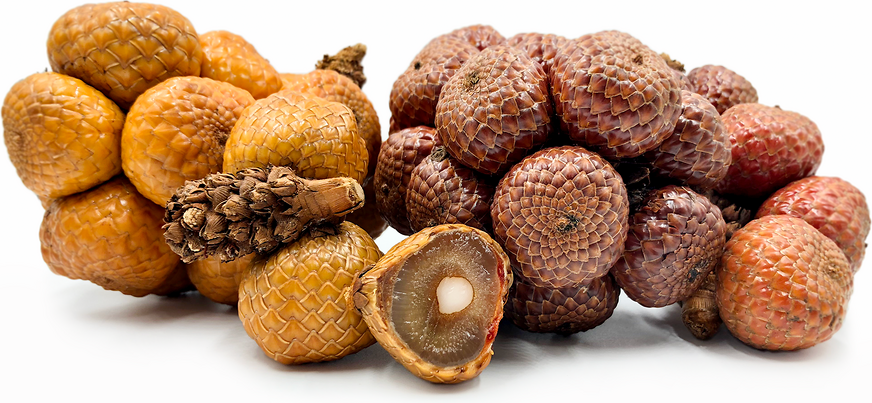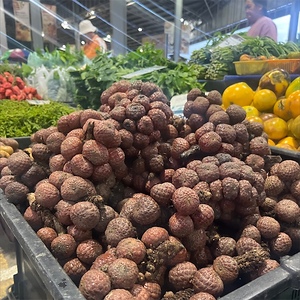


Asam Payak
Estimated Inventory, lb : 0
Description/Taste
Asam Payak is small to medium in size and tear-drop shaped with one bulbous end that tapers to a point. The scaly outer skin is red or yellow and easily flakes off in pieces when peeled. Beneath the skin, soft cream-colored round lobes encase one to two hard brown seeds in a juicy pulp. Asam Payak grows in clusters at the base of the palm and is extremely sour with notes of tropical flavors such as starfruit.
Seasons/Availability
Asam Payak is available year-round, with peak season late spring through summer.
Current Facts
Asam Payak, botanically classified as Eleiodoxa conferta, is a member of the Arecaceae, or palm family. Also known as Asam Kelubi and Asam Paya in Malay and Buah Maram in Iban, Asam Payak is the fruit of a palm that grows in swampy forest areas of Southeast Asia. It's quite literally named "sour fruit from the swamp" as asam in Malay means sour, and paya means swamp. There are two varieties, one red and one yellow, and the Asam Payak palm is a prolific grower and forms many large colonies. In Sarawak, a region of Borneo, it is commonly used by the Iban people to create borders to distinguish different longhouses and property lines.
Nutritional Value
Asam Payak contains some fiber, potassium, vitamin C, and antioxidants.
Applications
Asam Payak can be consumed in both raw and cooked applications. When raw, the fruit is sliced and commonly sprinkled with salt and chili powder to help cut the sour taste. When cooked, it can be simmered with simple acids such as orange juice, sliced, and cooked with fish, or juiced and used in drinks, sauces, and soups as a souring agent. Asam Payak is also popularly pickled and consumed as a snack. Asam Payak pairs well with chilies, ginger, turmeric, onion, salt, sugar, lime, calamansi, seafood such as fish, squid, and anchovies, and shrimp paste. Asam Payak will keep for a couple of days when stored in a cool and dry place.
Ethnic/Cultural Info
Asam Payak is traditionally used in the Malaysian dishes asam laksa and umai. Asam laksa is a popular sweet and sour dish that incorporates Asam Payak with fish, shrimp paste, anchovies, chilies, sugar, and salt. This dish can be served with rice or noodles and has a sour, spicy, and salty flavor. It can also be used in umai, which is a raw fish dish that incorporates fresh red snapper marinated with lime, ginger, salt, sugar, onions, and shrimp paste.
Geography/History
Asam Payak is native to Southeast Asia in peat swamp forest regions. It is primarily found in Sarawak, a state in Borneo, and can also be found in jungle markets in Thailand, Malaysia, and Sumatra.








